|
Dambusters 1951
The Shooters in 1/48 Scale
by Joe Lyons

HyperScale is proudly supported by Squadron.com
The Korean War provides a rich historical record of combat aviation
on the cusp of the jet age and nowhere is this more visible than carrier
aviation. USN air groups now included turbine-powered aircraft, all
fighters or fighter-derivatives. But the serious ordnance delivery
business remained the province of the props, and the two mainstays
flying off the wooden decks in that war are represented in this project.
The mission against the Hwachon Dam is described in several sources, but
I have used one (reference b) because it has not only a written
narrative but also a picture. And the picture shows all the fixed wing
type over the dam that day, the Douglas AD-4 Skyraider (VA-195), Vought
F4U-4 Corsair (VF-192/193), and the Grumman F9F-2P Panther (VC-61). The
picture, although possibly a USN photo and in the public domain, is
attributed to one of the participants and thus regrettably cannot be
presented here.
This project addresses only the first two. I had intended to include the
photo-recce Panther as well, but this was dependent on the release of
the Hobbycraft 1:48 F9F-2 (easily converted to a –2P). But, since my
biblical span of life is little more than a decade away, and since
Hobbycraft kit release cannot be determined, it seemed best to get on
with things before the project was overtaken by events.
The Corsair part of this project owes much to the assistance and
inspiration of Don Fenton and Snake. Both of these gentlemen freely
provided photos of Corsairs, actual and model, which together with
answers to many niggling questions about the U-Bird led me to press on.
The Hwachon Dam controlled the water level in a reservoir of the same
name that supplied the South Korean capital of Seoul. It became
strategically important in the early months of 1951 when the North
Koreans used its sluice gates to flood portions of the an area used by
UN forces to prosecute an offensive against the Chinese and Korean
armies retreating to the North. Attempts to capture the dam and
immobilize the gates had failed, as had attacks by B-29s to breach the
dam proper.
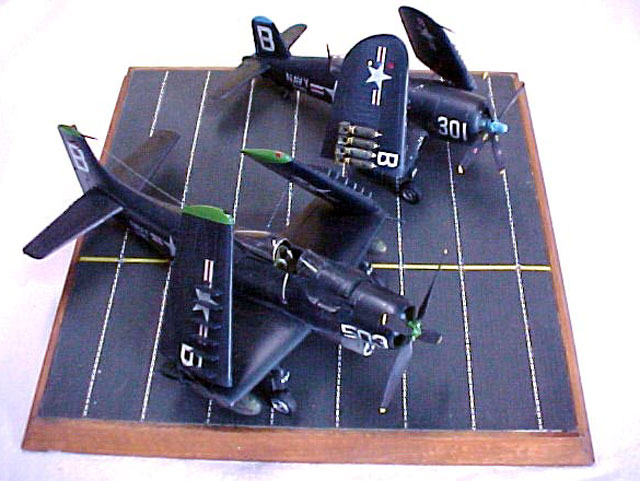
VA-195 ADs flying from USS Princeton (CV-37) had also failed to do
any significant damage during an April 30 mission using 2000 lb bombs.
Later that day, the CO of VA-195 (CDR Carlson), CO of Princeton (CAPT
Gallery) and the task force commander (RADM Oftsie) came up with the
plan to use Mk XIII aerial torpedoes. Most of the rest you know. ADs: 5
hits and one breached dam; dam: 0. See photo above (Reference c). VA-195
aircraft also carried napalm bombs along with the torpedoes and used
them on a secondary target after destroying the dam. A busy day for
‘195. The Corsairs did flak suppression.
Douglas AD-4 Skyraider
The SPAD was THE airplane in weapons delivery afloat for most of this
decade. VA-195 was equipped (reference f) with the –4 (the –2 and the –3
were also used in Korea). The photo in reference a shows the mission
aircraft to be equipped with 2 guns, and the time frame makes it too
early for appliqué armor (reference g) that would later be put on ADs as
a result of experience in this war. The AD-4 was an incremental
improvement to the AD-3 and differed visually very little from the
earlier versions.
On this mission the torpedo attack on the dam was of course, the main
event. The photo shows a Mk XIII hung from the centerline rack, with the
napalm bombs on the two inner wing racks. The torpedo clearly has the
plywood box tail for stability in the air after drop and the nose shroud
to ease water entry. I have no references that demonstrate the exact
configuration of the napalm tanks, but they look like teardrop shaped 75
gal drop tanks to me, painted GSB that has faded to reveal a lot of
yellow zinc-chromate underneath.
Vought F4U-4 Corsair
Not the biggest load carrier, but surely the one of biggest players
in this war. Corsairs flew more than 80 % of all carrier sorties in
Korea (I have read this somewhere, but can’t find the reference), and
were present in every air group of every carrier that dropped and fired
things that went bump in the day (and night). Just how much Corsairs
were used in Korea can be seen from another perspective: 312 out of 564
USN/USMC aircraft lost to enemy action were F4Us (Reference d).
Reference f shows both Princeton Corsair squadrons equipped with the –4,
and not the –4B. This reference is very specific on this type of detail.
Also, the photo shows the –4 outer wing ordnance pylon pattern, not the
staggered pylons of the –4B. I decided to do the earlier rounded
windscreen to customize the model; the photo does not reveal the type on
this airplane. Four bombs are visible on the folded port wing of this
shooter, and I assume that given the anti-flak mission, they are
fragmentation bombs. Almost all Corsairs in Korea seem to be carrying
the standard 150 gal drop tank, so even though it’s not visible in the
photo because of the angle I assume this aircraft did as well. A lot of
assumptions.
The Skyraider
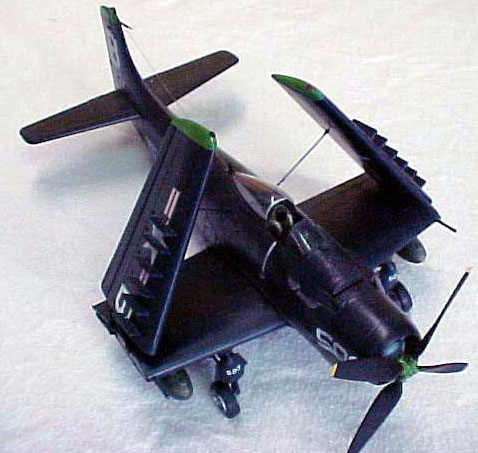
This shooter is the Monogram AD-6 kit back fitted to be a –4, and an
early –4 at that. The kit was built with the following deletions,
additions and modifications:
-
Squadron canopy in place of the kit
version.
-
Removed the outer wing cannon
-
Replaced the inner wing pylons
-
Added “napalm tanks” to the inner wing
pylons
-
Removed the molded Vietnam-era outer wing
ordnance from those pylons
-
Folded the wings
-
Removed the appliqué armor and rescribed
the panel lines
-
Removed the cooling gills in the cowl.
-
Added an upgraded torpedo taken from an
Accurate Miniatures armament sprue (from the AM TBM-3 “Yahagi” Avenger).
This sprue you may recall, was sold separately just at the end of the AM
saga.
This is an older kit and is not to the same level of detail of the
Tamiya kit, but acceptable nonetheless. It has an interesting pattern of
both raised and engraved panel lines, and it went together with little
trouble. I suppose that I’m glad that Monogram (and Tamiya for that
matter) molded the appliqué armor, for putting it on would surely be
harder than taking it off. Nonetheless, this was a chore, with much
grinding and sanding to get close to the desired result. The pylons were
easy to scratch build using the ones in the ERTL AD-4W kit as masters. I
had an Eduard cockpit set for this kit, but elected not to use it. The
Monogram cockpit is complete given the molding standards of the time,
and the Eduard set would have added nothing to it.
This kit has an obvious folded wing option molded in, in the form of
channels in the inner wing surfaces to take the visible folded wing
inserts provided as molded parts. A very nice touch, even though it
takes a bit of actual modeling to cut apart the wing sections and mount
them in the folded position, along with the struts to hold them in
place. Since a carrier aircraft spends 99.9% of the time on deck with
wings folded, I took this option. .025 wire provided the mounts for the
outer wings to attach to the inner wing sections.
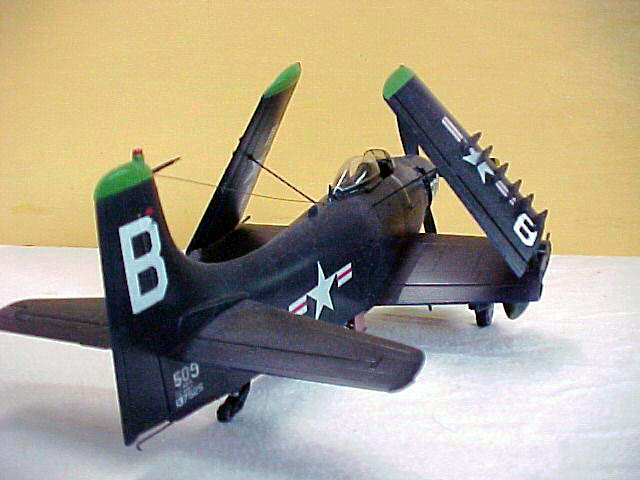
The basic AM torpedo is excellent (confirmed this past November when
examining the real item at the National Naval Aviation museum). However
the box tail as molded does not work. It is far too thick in cross
section and is best used as a template to make a new one from plastic
sheet. In the Avenger kit, AM presents the so-called “ring” tail and the
box tail as either-or options for the torpedo, when in reality they
simultaneously solved different problems for this weapon. The ring tail
provided structural rigidity and the box tail prevented rolling after
drop and the subsequent tumbling of the course-setting gyros. The nose
shroud prevented ‘skip’ as the weapon entered the water. This latter was
scratch-built using .010 clear plastic sheet.
The Corsair
This model was built using one of the two available F4U-4 kits in
this scale. Just which one escapes me at the moment, but Corsair experts
will doubtless know from the photos.
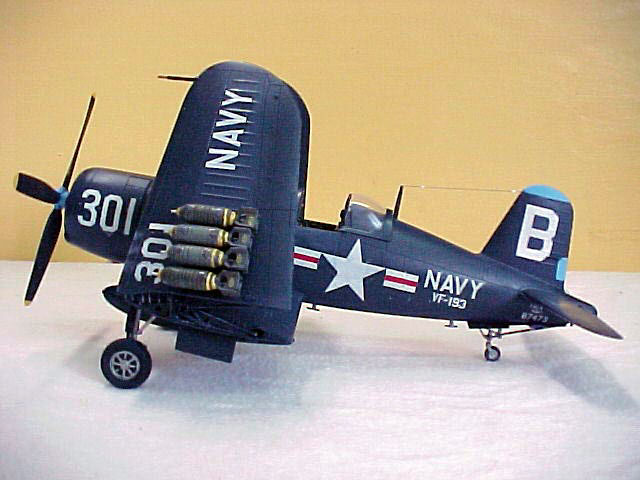
The following modifications or additions were made to the basic kit:
-
The wings were cut apart and folded. Wing
fold inserts and parts were taken from a Tamiya Corsair, fiddled with a
just a bit to fit. The struts were added from .025 steel wire.
-
True Details resin cockpit.
-
Falcon canopy
-
Rounded windshield, vacu-formed from the
canopy of an Otaki Corsair.
-
Internal armor glass inside the windshield
made from .030 clear plastic sheet.
-
Outer wing bomb racks from plastic stock.
-
250 lb fragmentation bombs using surplus
bombs from a Monogram A/B-26. The bombs were chucked into a power drill
to etch the frag indentations. Nose and tail fuzes added from wire, and
stencils from the P-M US ordnance decal sheet.
-
Kit prop replaced with a spare taken from
Monogram bubbletop P-47D kit.
-
Cut out the famous “step” in the starboard
inner flap segment.
The kit is somewhat basic, but seems to have all the Corsair parts
that it needs to be a Corsair. Good if not excellent engraved panel
lines and a nice engine; the latter’s crankcase being embellished with
dabs of filler representing those prominent bolts on this version of the
P&W engine. The fabric-covered parts of the outer wings are there and
seem appropriately restrained.
Click the thumbnails below
to view larger images:
  USN
air group markings of the period follow well-defined rules. The basic
airframe color is clearly specified as well. All USN tactical aircraft
of the era are painted overall Glossy Sea Blue (GSB). I used Model
Master Glossy Sea Blue for the both aircraft of this project. USN
air group markings of the period follow well-defined rules. The basic
airframe color is clearly specified as well. All USN tactical aircraft
of the era are painted overall Glossy Sea Blue (GSB). I used Model
Master Glossy Sea Blue for the both aircraft of this project.
The AD is marked with the “B” for this air group and is in the 5XX range
of side numbers for the fifth squadron. MM Willow green wing tips, top
of the fin, and prop hub show off the color for the fifth squadron
(Reference a). “503” where appearing and “B” taken from various decal
sheets. Other markings are kit decals, modified for squadron number,
etc. The torpedo body is done with MM Steel Buffing Metalizer, the
plywood tail with Sand, and the nose shroud with someone’s light gray.
VF-193 Corsairs occupy center stage of the cover of Reference e. The F4U
is in the third squadron (3XX) and carries the light blue (Testor’s
1162) of this squadron on the fin tip, rudder trim tab and prop hub.
“301” where appearing from decal sheets, other decals from kit. I used
up all my “B” decals on the AD, so these were sprayed on using a reverse
stencil. The “Ghostriders” insignia for VF-193 was copied from a web
site. It is a sort of vague squadron badge even up close, and would not
print satisfactorily on decal paper using a color laser printer. The
following, technique, while probably not done on the better workbenches,
at least got the emblem onto the model: I printed the emblem on paper,
cut it out, and varnished it to the model with Future. Would you know if
I hadn’t told you?
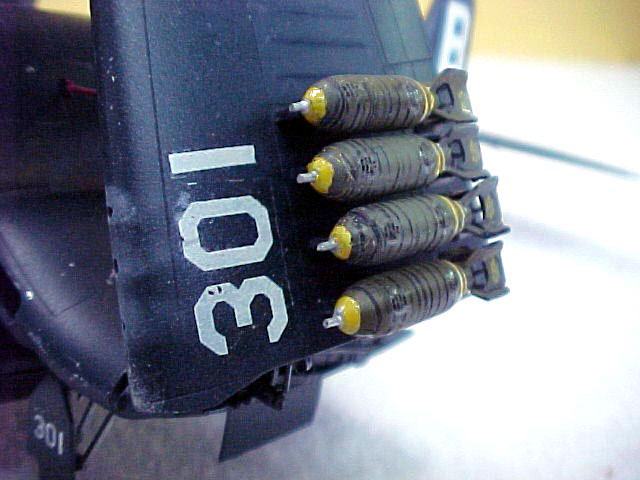
Both aircraft are moderately weathered, most prominently
with exhaust stains and gunpowder stains done with pastel chalks.
One more aircraft from Princeton was surely airborne that day, the
Sikorsky HO3S-1 helicopter possibly flown by the HU-1 det OinC, Lt(jg)
John Koelsch. It was once my privilege to serve on the frigate named for
him, USS Koelsch (FF-1049). His portrait hung in the Wardroom directly
under the upper handling room for Mount 52, a 5”/38 cal gun with “1942”
stamped on its breech.
During gunnery exercises the portrait was taken down, lest the shock
send it flying across the room. Lt(jg) Koelsch survived his tour on
Princeton, but not the war. Shot down during another tour on a mission
attempting to rescue a downed pilot, he was to die in captivity.
His performance during that last mission and his leadership in the
POW camp were to earn him a posthumous Medal of Honor, and of course
remembrance via a destroyer-type named for him.
-
Elliott, H.M. (1991). The Official monogram
US Navy & Marine Corps aircraft color guide Vol 3 1950-1959. Sturbridge,
MA: Monogram Aviation Publications.
-
Bruning, J.R. (2000). Crimson sky the air
battle for Korean. Dulles, VA: Brassey’s.
-
Grossnick, R.A. (1995). Dictionary of
American naval aviation squadrons-Volume I The history of VA, VAH, VAK,
VAL, VAP and VFA squadrons. Washington: Naval Historical Center. [The
source of the lead photo]
-
Hallion, R.P. (1986). The Naval air war in
Korea. Baltimore, MD: The Nautical & Aviation Publishing Company of
America.
-
Kasulka, D.A. (1985). USN aircraft carrier
air units volume 2 1957-1963. Carrollton, TX: Squadron/Signal
Publications, Inc.
-
Korean War Combat Deployments. (1989,
Summer). The Hook: Journal of Carrier Aviation], 17-2.
-
Rausa, R. (1988). Skyraider. New York:
Kensington Publishing.
Model, Text and Images Copyright © 2003 by
Joe Lyons
Page Created 20 April, 2003
Last Updated 17 March, 2004
Back to HyperScale
Main Page
|
Home |
What's New |
Features |
Gallery |
Reviews |
Reference |
Forum |
Search